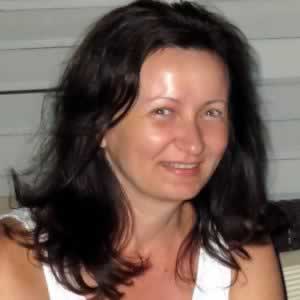Last Updated on: 16th September 2023, 02:23 pm
#1 Geneva Tour

Geneva 3-hour chocolate tasting tour & old town visit
- ☑ The tour includes an expert tour guide, lots of stories and anecdotes
- ☑ A chocolate tasting event with chocolates in all shapes and flavors
- ☑ A tour of the main landmarks and lesser known spots in Geneva
- ☑ A short boat ride
  Duration: approx 3 hours (the tour starts and ends Quai des Bergues 23, 1201 Genève, Switzerland)
 Duration: approx 3 hours (the tour starts and ends Quai des Bergues 23, 1201 Genève, Switzerland)- âï¸ Rating: 5 out of 5 stars (1441 reviews)
Main Topics of A Day in the Swiss City of Geneva
A day in the Swiss city of Geneva
The gateway to Western Switzerland, Geneva (or Genève in French), is one of those cities which has charm, beautiful buildings, stunning surroundings and a heck of a lot of watch shops.
For us, it is one of those cities where we either fall in love with her or hate her immensely as we have been several times. The very first time we came here, we hired a car, drove into the centre as the city was the first stop on our road trip around Central Switzerland, parked in an underground car park, went upstairs to street level and whilst on the pavement as I was looking at a map in my hands, a pigeon shat on my head. I had pigeon poop all over my hair and shirt. Welcome to Geneva I was thinking.
Was this going to be the theme for my visit to the city in general? Was the pigeon warning me that I might suffer ‘open wallet surgery’ because of the amount of money I could be spending. Was I going to get Swissed by the locals (a common term used by the English when they get outdone by the locals, either in wit or cash), Well, not really. I had further mishaps with the locals and nature in other parts of Switzerland later on and on other visits to this beautiful country, however Geneva was kind to me and us after that moment.
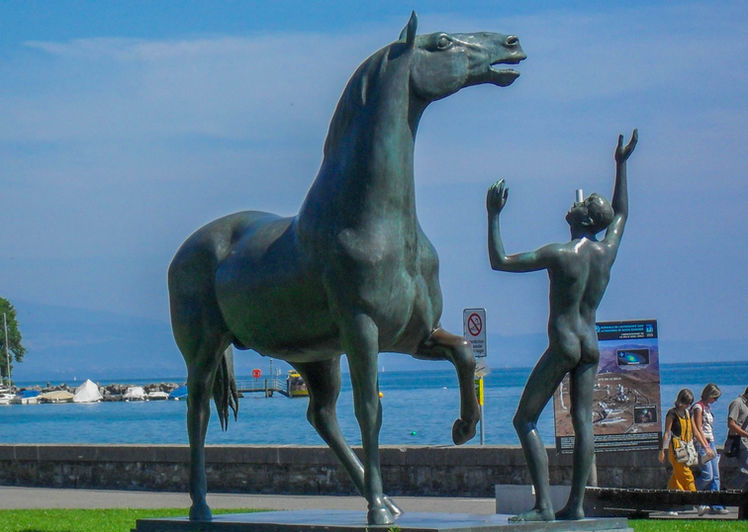
How Many Days To Spend in Geneva?
Geneva is one of those cities (like the other cities in Switzerland) where you might just need a day or two.
We always say to people who are thinking of coming to Switzerland to go for nature, not the cities. Get into the mountains or by a lake and just enjoy the fresh Alpine air.
If you are like us, one day is enough here if you don’t do museums and art galleries (or spending several hours deciding which watch you want to buy) and a lot of the trip can be done on a budget.
Is Geneva Expensive To Visit?
This might sound a bit crazy but out of all the cities we have been to in the country (and I have done a lot of Swiss cities for some unknown reason, rather do a lot more hiking but hey ho), Geneva was actually the cheapest for us.
We didn’t stay here (we stayed in a hostel in the mountains not too far from Lake Geneva) and we didn’t pay any money for attraction entrances etc.
I think we had McDonalds to keep the cost down, brought a postcard, an ice cream (as it was a lovely warm summer day) and that was it. We didn’t even buy a watch (and for those who know us well, we always buy Swiss Watches, however that was to come later on in all our trips, we think we have four now, still in good condition and locked up in the safe).
Then on our other visits to Geneva, we kinda did the same again and probably only spent around 25 Swiss Francs – CHF.
What To See in Geneva in One Day?
So why do people come to Geneva?
We have to admit we didn’t do our research on our first visit to the city but we knew it was on the western end of Lake Geneva (Le Léman in French), it has international organisations such as the United Nations and the Red Cross based here and that is a French-speaking city within Switzerland.
Of course as time went on, we got to know the city a lot better so why did we want to come here? To be frank, it was just for lunch by the lake but we didn’t even do that, it was a McDonalds on the shopping street on our first visit.
As we walked around the city it became clear why people visit the city. Standing by the lake, we saw the mountains to the south, calm waters in front of us, a few people walking about (or running, cycling), hardly any noise, did we come here on a good day or is Geneva like this all the time?
If so, then the city is one of the calmest we have come across on our European adventures. We could see a lot of locals doing water sports on the lake such as paddle boarding (which visitors can also do as I found out). You get the picture now, the locals love the outdoor lifestyle.
Apart from a pigeon sh**ing on my head and describing the calmness of Downtown Geneva, it’s time for us to give you the lowdown on what you can do on a one day visit.
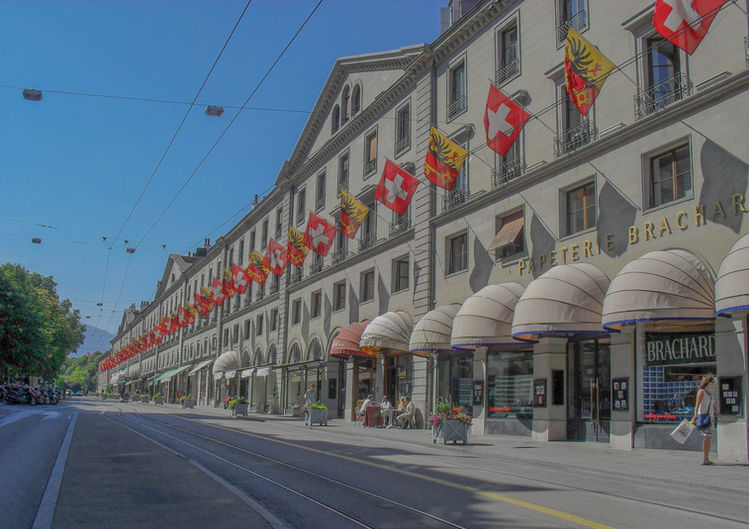
History of Geneva
We give you a quick rundown on Geneva’s past, so it all started out as a settlement (built by the Helvetii tribe) a couple of hundred years before Christ was born before the Romans came along and took it.
After the Romans introduced Christianity to the region, it stayed within the Holy Roman Empire until around the 14th century when it got a bit messy. The House of Savoy came to rule the city (and ruled the area of northwestern Italy and the Cote d’Azur in southeastern France) and this lasted under two hundred years before the Savoy’s got kicked out and the city aligned itself with the Swiss Confederacy.
Whilst land borders were changing all the time, so was religion. Christians, then Catholics and then protestants came and went (we won’t go too much into this). In the 18th century, as Geneva lies on the border of France, the French tried to take the city by influencing the town folk which didn’t work for years, however in 1798, the French got fed up and annexed the city.
Geneva was now part of France (during the period Napoleon decided to go on a rampage across Europe and conquer many lands, some successful and some not so), but at the end of the Napoleonic wars in 1814, Geneva returned to Switzerland. All has been peaceful since then, the city has flourished, international organisations are based here and everyone is happy.
What Visitors can do in Geneva
Now to the present day and what visitors can do when going walkabouts in the city.
The Old Town of Geneva
We are going to start in the area known as the Old Town (that is what we call it).
The best way to describe how to get to this area is if visitors are in the Jardin Anglais (English Garden) which is a small park area next to the shores of the lake, turn around and there is a hill.
Just walk straight, passing a couple of the blocks, up the hill and this is the Old Town area. (Or you could just follow the tourist signs for the cathedral or find the road Rue d’Italie and turn right after a couple of blocks…makes sense right?). In this area you will find cute little squares with small cafes and quaint shops.
However the main building in this area is St Pierre Cathedral. We always check out the main cathedrals if we can and see the architecture. However, for this place, it is also one the better places to grab a view of Lake Geneva down below.
On warm sunny days, head up to the south tower as it has an open air balcony but if the weather is not so kind, head to the north tower where it’s a little bit more warmer and sheltered. The views from here are amazing and worth checking out.
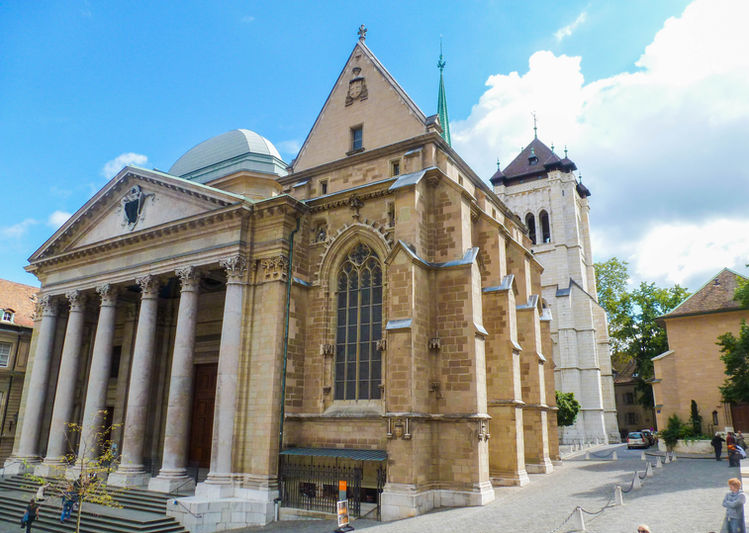
The Giant Chess Boards on Rue de la Croix-Rouge
Another place worth checking out is the park area on Rue de la Croix-Rouge (just east of the University of Geneva grounds). Here there are giant chess boards to be enjoyed, a ‘reformation wall’ which celebrates and honours the ‘Protestant Reformation & its founders), however, it’s the Banc de la Treille.
Not only is it a viewpoint to see the amazing rooftops of the city down below but this is also the place for the world’s longest bench. Can’t miss it, it’s a green wooden bench which goes all the way along the terrace.
A top tip for us around this part of Geneva, wear comfortable walking shoes. It’s all cobble streets and a bit hilly. If you need a rest or want a lunch, there are a lot of places around here which serve Fondue. It is a must whilst in Switzerland.
Jet d’Eau on the Shore of Lake Geneva
Back at the lake shore, the highlight has to be the Jet d’Eau (sounds a lot better in French doesn’t it? In English it translates into ‘Water Jet’ which is a bit of a meh!). Not much to say about it apart from the fact it is a water fountain chucking up thousands of litres of water up into the air. If you stand near it on a windy day, please take an umbrella or at least have a spare set of clothes on you. You will get rather wet if caught out.
Jardin Anglais (the English Garden)
The Jardin Anglais (English Garden) by the lake shore is a nice place to take a stroll (maybe after eating a lot of fondue) and is famous for the Flower Clock which has been here since it was created in 1955 (ok, the design may change now and again). The clock is made out of plants and flowers and is simply stunning. A great creation. It is now one of the most visited attractions in the city, however it is quite small so don’t expect too much from it. See it work (it is a proper functioning clock) and take the touristy photo but then move on around the garden and down the promenade.
Other things to do and see in Geneva in one day:
Check out one of the ninety wineries in the area. The Geneva region is the third largest wine producing region in Switzerland.
Mont-Salève is located outside the city. Take the cable car up the mountain for views of the surrounding area. This is also a great area to do outdoor activities such as mountain biking and hiking. Even cross-country skiing takes place here in the winter.
There is also a lot of chocolate made in the city, so go and check out a chocolate factory to see how Swiss chocolate is produced. It’s true, the chocolate in Switzerland is one of the best in the world.
Geneva Advice
Make sure you leave the airport at the right exit: If you’re new to geography in this area and you’re probably wondering why we mention this. Geneva airport is located in France as well as Switzerland. The border goes through it. So, when going to passport control, customs, baggage reclaim etc, make sure you go to the Swiss exit. If you go through the France exit, you land up in some sort of industrial estate with car rentals and it’s not pretty for a few miles (however, it’s France, so if going to this part of France, Geneva airport may be an option for you and the car hire is cheaper).
Transport to and from the airport: The airport lies a few kilometers away from the city centre and is easy to get to by bus and train. (However, if you get a taxi, it’s going to cost you!).
Tips about driving in the city: If renting a car or driving a car from a neighbouring country, make sure you have a license and the necessary paperwork. Driving around the city is pretty easy and is not too busy during the daytime. Parking up here can be expensive, but when we did this, we parked in the underground car park, Parking du Mont-Blanc on Quai du Général-Guisan (which is very near the lake shore and the Jardin Anglais).
The Geneva Pass: If visitors are looking to spend a few days here and want to visit museums etc, then buying the Geneva Pass will suit you. It is a money saver.
- Free admission to over thirty attractions in the city.
- Free public transport in the city.
- Free tours & equipment rental including a lake cruise, kayak rental, open bus tour & walking tours
- Discounted city tours & day trips outside the city
Buy it online and there is a 10% discount. All the information you need for the pass can be found here.
Another transport money-saver: We have been told about this and seen this online but we can honestly say we haven’t tried this but thought we would mention this. If visitors book accommodation in Geneva (such as a hotel, hostel or a nearby campsite), visitors are entitled to receive the Geneva Transport Card for free.
This will give visitors free journeys on the trams, buses, trains and the taxi-boats (they are the yellow ones on the lake), within Geneva. Just ask for it when checking in at your accommodation.
Language: It’s a French speaking city (the locals have the Swiss-French dialect but understand ‘French’ from over the border down the road). But don’t worry if you do not speak French, they also speak English, or should I say American because Switzerland learns American English and not British English. This is because of the business and finance sectors between the United States and Switzerland.
However, like the rest of Switzerland, in the tourist shops or tour groups, there will be people speaking Chinese and Japanese. Switzerland does have ‘four main languages-dialects’ but it’s mostly French here. The others being German, Italian and Romansch.
Currency: Swiss Franc is the money talker here however some shops and restaurants will take the Euro currency but be wary of an admin-fee if any. Credit cards are accepted everywhere.
Time of year to go: Geneva is an all year round city to visit, however April to September is the best time to go. The temperatures are not too bad, it’s sunny, still take a jacket just in case.
From October to April, its winter season, sometimes it will snow hard, sometimes it won’t. Just bring the right gear guys. We have done Geneva in the Autumn as well and the temperature was pretty mild.
Conclusion
Don’t miss Geneva if visiting this region. It is pretty and our favourite time to visit is in the summer months. Hopefully we can spend more than a day here on my next visit and include many of the attractions we haven’t done yet. Out of all the Swiss cities and towns,
Geneva is one of our favourites because of the laid back attitude, scenery and how easy it is to get around the city. The only thing we do not like about Geneva are the pigeons.
About Supraja Lakshmi N
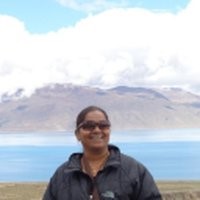
She is a travel content writer in Bangalore, India and publishes articles about vacation ideas in her website.
Follow her on Twitter.
- Dingli Cliffs: How To Visit Malta’s Highest Point - April 24, 2024
- Blue Grotto Malta - April 23, 2024
- Ramla Beach Gozo, Maybe the Best in Malta - April 9, 2024

